A landscape photographer pays close attention to composition, and of course, you want your picture to be as sharp as possible—or should I say acceptably sharp? Sharpness helps to provide depth to your landscape photo. You need critical sharpness, especially for larger prints. In this blog, I will provide 14 valuable tips for sharper landscape photos. I hope you enjoy them.
Tip# 1. Start to use a tripod
1) Choosing a tripod
The most obvious and easy way to add stability and sharpness is to use a tripod. Many amateurs complain about the weight of carrying a tripod around, but nothing else than a good camera tripod will help you achieve consistently sharp landscapes.
In your lifetime as a photographer, you will probably have to buy several types of tripods before you find the right one. Many start with a cheaper version because of budget restrictions, but soon, you discover that those do not always offer you the desired stability. Choosing based on budget, weight, and maximum and minimum height would be best. There are so many factors to take into account. If you love macro photography, you might find one that allows you to come as close as possible to the ground. You might like the lighter-weighted carbon versions if you hike into the mountains. You will need a sturdy pair of legs when you enjoy working in hard, windy conditions. If you wander a lot in rivers or the coast, they must be water-resistant.…
Many brands offer good quality, and they provide a range of choice of designs.
For my work, I use a sturdy carbon and waterproof Sirui tripod. But sometimes I want to travel light, so I use a smaller, lighter travel tripod that fits in my suitcase or backpack.
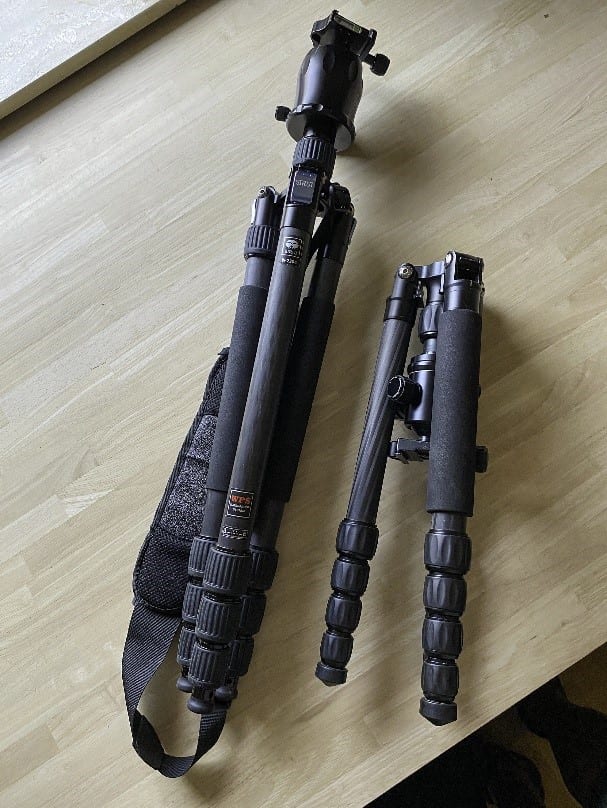
2) On your way with a tripod
Ensure that everything is tightened up correctly, the legs are locked, and the head hasn’t loosened. When walking around, the head often slightly loosens, and that is, of course, not good for stability.
Windy weather can destabilise your camera, mainly if you use a long lens or have a filter system with filters attached to the front. I experienced this when a gush of wind tripped over my tripod and smashed the camera on a rock in the Scottish Highland. Try stabilising the tripod as much as possible by splaying the legs wide enough and pushing them firmly down into the ground (providing the ground is soft), or hang a heavy bag at the centre column. Some tripods have a hook at the bottom of the centre column. This extra weight makes the tripod even more stable. But be sure not to let your bag swing freely in the wind because this will only increase the possibility of unsharp images. Also, swinging camera straps in the wind can have the same effect. It is best to remove the camera strap. If you’re on a beach, press the tripod further into the sand so it doesn’t sink in when you’re taking the shot.
If you are on a wooden pier or bridge, do not walk around on it while you are taking the photo, as this may cause the camera to sway a bit.
Sometimes, you see people holding their tripod while shooting. This is often a sign that the tripod is not sturdy enough, and there is a fear of it being blown over. Holding the tripod can also cause small vibrations. Any vibration will result in a slightly blurred picture, so preferably, do not touch the tripod while shooting.
Tip# 2. If you insist on shooting hand-held
When you do not have a tripod, it’s simply a matter of keeping the camera as steady as possible. Try to find a makeshift tripod. We’re surrounded by objects that can make perfect natural tripods. Rest your camera on a wall or a pole. Bracing yourself against a wall or any other solid structure will help steady your body while shooting hand-held.
There are a few tricks to optimizing sharp images. The first is to have a firm grip on the camera. Grab the camera with one hand on the lens and another on the grip, and keep the camera as close as possible to your body. I prefer to keep the camera at eye level and look through the viewfinder. Doing this, the camera can rest on my face, which helps keep the camera as steady as possible.
Use your breath to your advantage. So, when you breathe out, wait a second, take the shot, and then inhale again. Instead of just shooting away while inhaling, take the shot when there are no vibrations, and then you’re good. Of course, you can also put the option image stabilisation on again when you are hand-holding after switching it off when using a tripod.
Tip# 3. Turn off image stabilisation
The stabilisation on your lens can do wonders for handheld shots, but it is better to switch off optical image stabilisation when your camera is securely fixed to a tripod. Your equipment will try to stabilise movement that is not present, which might soften image quality.
However, I have experienced a few times when, in windy conditions, even a sturdy tripod is not enough to keep the camera from shaking. You can turn image stabilisation back on again, but you need to figure this out on location. Stopping shooting and returning on another occasion might be better in such conditions.
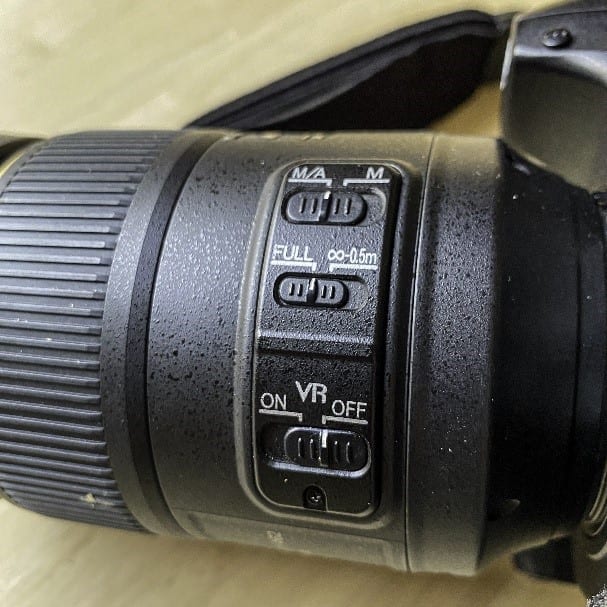
Tip# 4. Go for a small aperture
You will require a large depth of field if you want front-to-back sharpness in your landscape photos. Of course, focal length, camera-to-subject distance, and point of focus all together will influence the perceived depth of field, but the aperture is the primary control method. Depth of field (DOF) refers to the zone of acceptable sharpness in front and behind the point of focus. With smaller apertures, you will obtain a wider depth of field than large apertures.
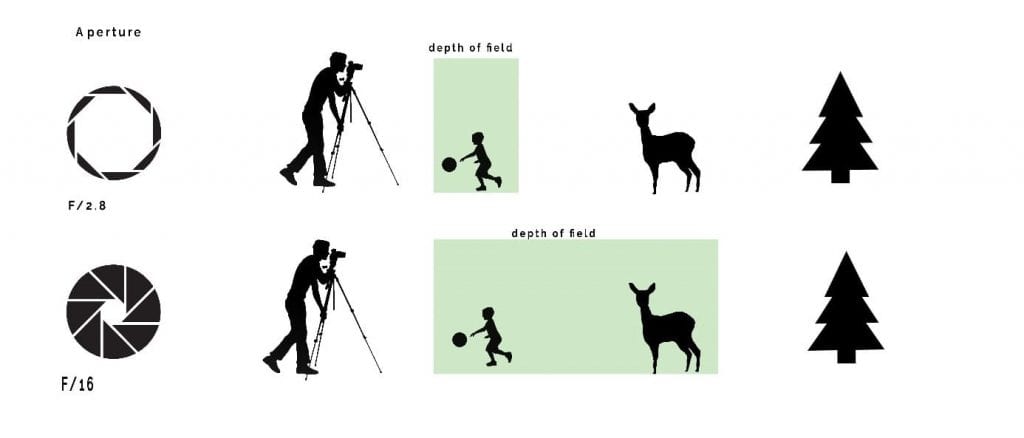
Aperture is measured in F stops, and it can be tricky to understand because when you increase the F stop number, you make your aperture smaller. That might sound a little counterintuitive. However, there is some logic behind this because your F-stop number is a fraction. So, when you have F 4, it is 1/4. And when you have F 8, it’s 1/8. Obviously, 1/8 is less than 1/4, so that is why your aperture gets smaller when you increase the number.
Be aware that your sensor size plays a role. Crop cameras and anything smaller than a full-frame lens tend to have the sharpest point of their native lenses at a slightly lower F-stop value. So, let’s say F 6 compared to F 8 on full-frame.
Due to the effect of diffraction, the smallest aperture of F 22 or F 32 is not the best choice. When light passes through the aperture, it strikes the edges of the diaphragm blades and diffracts or scatters, affecting image quality. Diffraction tends to make images more ghostly or soft.
As explained in previous blogs, a good starting point is a mid-range aperture around F 11, but some optics may perform best at around F 8. You need to experiment with this for your particular lens to find the so-called “sweet spot” where it performs at its sharpest.
Tip# 5. Use the hyperfocal distance
Do not be frightened by the terminology. A lens can only focus precisely on one vertical plane at a certain distance, and sharpness gradually decreases on either side of this distance.
From experience, we noticed that the depth of field extends one-third in front of this point and two-thirds beyond it. That means that if you focus too close or far away, you will waste some of the depth of field available.
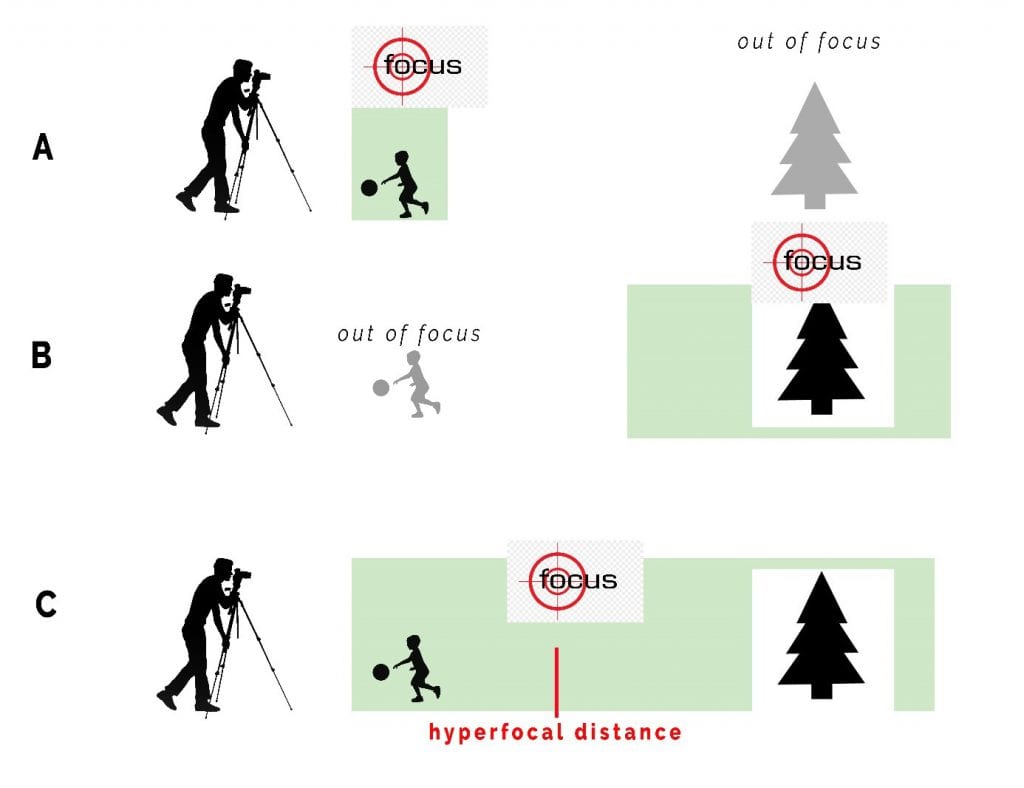
The hyperfocal distance refers to the point at which you focus to maximise depth of field. – If you focus at the hyperfocal distance, you get the sharpest possible part of the scene. – You will render everything from half the hyperfocal distance to infinity acceptable sharp when using the hyperfocal distance.
We need to understand that, for every focal length and aperture combination, there is one distance that will maximise depth of field, and this is the so-called “hyperfocal distance”. When you focus on this point, you will take advantage of the full extent of the depth of field. Sounds complicated? Hyperfocal charts and handy apps are available for different sensor sizes. These charts or apps will help you calculate this optimum point. One of those apps is Photopills, but there are more Apps available in the Apple Store. Enter the selected focal length and aperture, and the app will calculate the distance you need to focus on and show the near and far limits.
Suppose you are out in the field without such a chart or App. In that case, focusing on roughly one-third of the distance is always a safe choice. However, in practice, you often want more sharpness in the foreground. In landscape photography, we usually deal with objects or lead-in lines in the foreground that we want to have sharp. Therefore, you often focus on your photo’s primary subject and/or foreground.
Tip# 6. Focus via Live View
Under normal circumstances in landscape photography and with the sophistication of modern auto-focus systems, the viewfinder works perfectly. However, with subjects that need precise focusing, like macro photography or architecture photography, focussing via the live view in combination with manual focus will be the best solution. If necessary, use the magnify button to check and adjust the sharpness of your image. Scroll around the scene from front to back.
If light reflecting off the live view screen makes it hard to see, you could use a loupe that fits over the screen.
Tip# 7. Keep your finger from the trigger
Using a tripod is only the first step to achieving shake-free results. Pressing the shutter might cause a slight tremble, softening the image quality.
Do you need to spend a lot of money on remote triggers? Well, that depends on what you want to do and how often you will use it. But your camera is already equipped with a perfect solution. Select your camera’s delay or self-timer option to set a short delay of a few seconds. This way, you can eliminate any risk of causing movement when taking photos. This ensures that when you hit the shutter, you can remove your hand and ensure the camera is steady when it takes the shot.
A remote trigger will also be a good solution. This remote device is connected to the camera via a cable or infrared to release the shutter. For some cameras, you can use specific Apps to trigger the camera from your phone. Simple and cheap solutions are available, sophisticated and more costly versions with built-in timers for long exposures and solutions for time laps, etc.
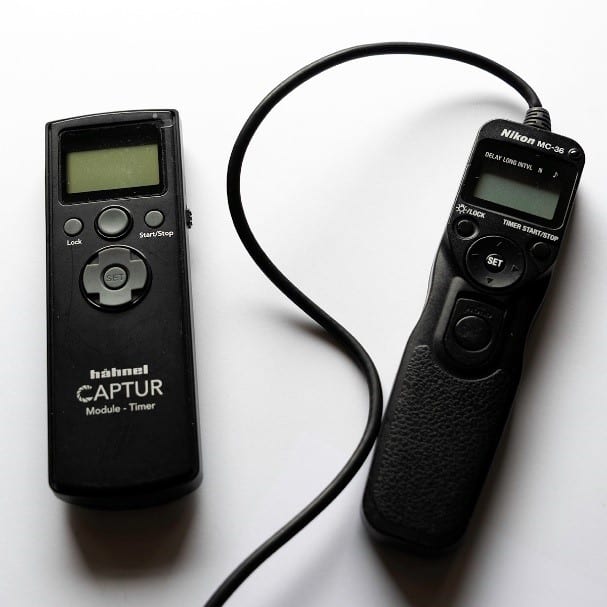
Tip# 8. Mirror lock-up
If you use a mirrorless camera or take photos with Live View activated, you can skip to this part. However, keep reading if you use a digital SLR with a viewfinder.
When you take a photo, you can hear the internal reflex mirror swinging up and out of the light’s path towards the sensor just before opening the shutter. This action can cause tiny movements that impact the image’s sharpness. You can avoid this by selecting your camera’s Mirror Lock-up function (consult your manual). Some entry models might not have this possibility. With Mirror Lock-up enabled, you must press twice to take a photo. The press will lock up the mirror while the second press takes the photo. Pause a brief moment between locking up the mirror and taking the photo to enable any internal vibrations to stop. When the mirror is locked up, you can no longer view the scene through the viewfinder. Using Mirror Lock-up is a valuable method to maximise critical sharpness.
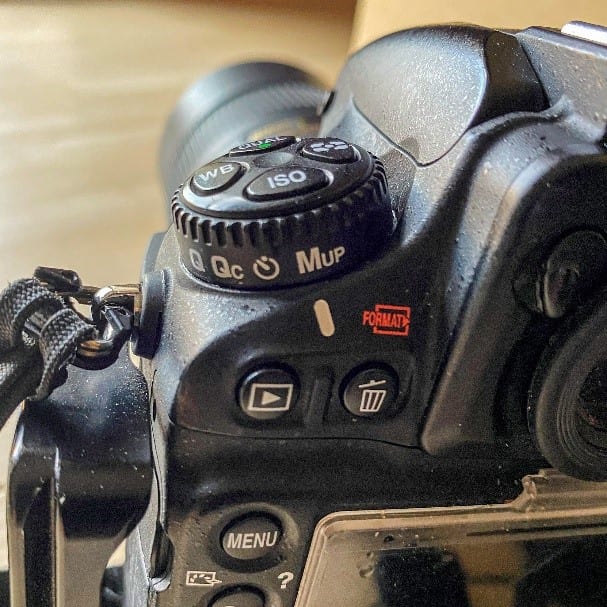
Tip# 9. Use good lenses and keep your equipment clean
Good quality lenses can make a difference to the sharpness of your photos, and more expensive lenses are generally sharper than cheap ones. It all comes down to lens design, the quality of the glass, and how much glass there’s in the lens. That is also why prime lenses tend to be sharper: simply because they have less glass.
If you compare a professional prime lens with a professional zoom lens, you can observe a sharpness difference at the pixel level. Zoom lenses are a wonderful invention and are easy to use. They save you weight because you need fewer lenses. However, there is also some bad news because zoom lenses rarely work at their sharpest at the extreme ends of their zoom range. You might want to test your gear, but you will likely find that any zoom lens is sharper in the middle of its zoom range and not necessarily at its widest or longest focal length. So once again, you will have to compromise between the ease of us, the weight on one hand, and super quality on the other. But in many cases, the negative impact will not be so huge and may even go unnoticed if you have a professional quality zoom. However, you can usually see quite a significant difference when comparing a professional zoom lens with an entry-level one.
Tip# 10. Take off that filter if you do not need it
Filters in front of your lens can reduce its sharpness. So, take them off when they’re not required to improve clarity. If you need them, ensure they are clean because they can easily catch droplets and dust. Therefore, keep a cloth at hand to wipe it off.
For the use of filters, see also these articles:
- Handy tips about using filters for landscape photography (part 1)
- Handy tips about using filters for landscape photography (part 2)
- Handy tips about using filters for landscape photography (part 3)
Tip# 11. Increase your shutter speed
When you work on a tripod, the shutter speed is not so important, but when you shoot handheld, it will become important again, especially if there is less natural light, like in the shade of a forest. A faster shutter speed is less susceptible to movement, so increase it as far as possible. You probably have the question: “How far must I increase the shutter speed?”
An easy rule of thumb is to use a shutter speed of at least “1/focal length.” So, for a 100mm lens, you would want to use a speed of 1/100 of a second or faster.
When you increase the shutter speed, the light will decrease, so you can either open up your diaphragm or increase the ISO. Because of the desired depth of field, you could be limited in changing your diaphragm, and only ISO can be increased.
Tip# 12. Focusing on low-light conditions
In low-light situations, focusing can be challenging. This happens often before sunrise, after sunset, and in a forest under the leaf cover. The camera autofocus may take a long time to search and then fail to focus because it is too dark. The same can happen during the day when working with filters or when it is heavily cloudy or shady and you work with a small aperture. Remember, this is also the case if there is almost no contrast in the scene, such as in water, sky, or snow. The autofocus does not function properly then. There are a few possible solutions to this:
- Work on live view. On some cameras, the autofocus still works well in low light when you work on live view.
- Open the aperture to its widest margin. More light will fall on the sensor, improving the autofocus module’s performance. After focusing, set the lens or camera to manual so the focus does not change again. Don’t forget to set the aperture back to the desired value.
- Remove the filters. If you are working with filters like the big or super stopper, you have no other option than to remove them temporarily. You will most likely be able to focus then. Then, repeat what we just described in the previous option. Before removing the filters, don’t forget to check which focal length you have chosen. When you replace the filters, the settings may change.
- If none of the above works, focus manually. When looking through the viewfinder, make sure the eyepiece is adjusted correctly.
Tip# 13. In the air?
We are not photographing in vacuum conditions. The farther away your subject is from your camera, the more distance light must travel through the air to reach your lens. Haze, smoke, fog, smog, heat, turbulence, and more can prevent you from getting a sharp image of a distant object. Get closer if you can, or wait for different conditions.
Tip# 14. Sharpening photos in editing software
If images are blurry, they are usually useless. Of course, some photos are intentionally blurry for effect (intentional camera movement). But in general, sharpness can make or break a photo.
Even photos taken with the most care while keeping vibrations to a minimum while shooting, most photos can still benefit from a bit of sharpening in a program such as Photoshop or Lightroom.
Excellent sharpening programs are available as stand-alone software or plugin versions, like Topaz Sharpen AI ®, that work with the newest AI technology.
Of course, an unsharp photo can never be restored to a completely sharp image. There is only so much you can do in post-processing.
Focus stacking (combining photos in Photoshop with different focal points) will be treated in a separate blog.
Conclusion
Focusing remains the most significant challenge in landscape photography, but achieving tack-sharp images isn’t impossible; it does involve adjusting as many “small things” as possible. Each might only make a tiny difference, but the cumulative effect will result in sharper photographs. Sometimes, you have to push it to the limits, which is the fun part of landscape photography; “knowing what you are doing and learning from it”. After a while, you will not need to think about it anymore unless you start shooting hand-held.
As always, I appreciate your reading of this blog. If you have any questions, please leave them in the comment section below, and I guarantee I will get back to you.
Leave a reply